Chapter 2 Very high blood pressure that exceeds 200/120 mm Hg is relatively uncommon and affects only 0.5% of the adult population. Malignant, or malignant phase hypertension with retinal haemorrhages, exudates with or without papilloedema is even rarer, being seen in about 3 per 100 000 population. Malignant hypertension carries a very grave prognosis when untreated, with nearly 90% of patients dying within 2 years (Figure 2.1). Figure 2.1 The 2-year survival of moderate-to-severe and malignant (MHT) hypertension before the advent of acceptable antihypertensive therapy. Source: Data from Leishman, A.W.D. (1959) British Medical Journal, 1, 1361–1368. Most patients die of renal failure, stroke or left ventricular failure. With modern treatment, survival is much improved, with >90% of patients surviving 5 years (Figure 2.2). Age, decade of MHT diagnosis, renal function (as reflected by baseline creatinine) and follow-up systolic blood pressure were all independent predictors of survival (all p < 0.0001). Figure 2.2 The 5-year survival by decade in patients with treated malignant hypertension, at City Hospital, Birmingham. Source: Reproduced with permission from Lane, D.A., et al. (2009) American Journal of Hypertension, 22, 1199–1204. © Elsevier. Early detection and management of mild grades of hypertension means that malignant hypertension is declining in incidence. Often, no underlying cause of the increased blood pressure is identifiable, but intrinsic renal disease is seen more often in patients with malignant hypertension than in those with non-malignant hypertension. The pooled data from many of the long-term follow-up studies of well-defined unselected populations now means that accurate data are available on the relation between baseline blood pressure and the subsequent risk of heart attack and stroke (Figure 2.3). Figure 2.3 Mortality from coronary heart disease (top) and stroke (bottom) in relation to systolic and diastolic blood pressure at screening. Source: Reproduced with permission from Lewington, S., et al. (2002) Lancet, 360, 1903–1913. © Elsevier. This close relation between the height of the blood pressure and the risk of heart attack and stroke continues down to pressures that are average or even below the average for the general population. This means that people with systolic blood pressures as low as 130 mm Hg are at greater risk than those with even lower pressures. In the absence of concomitant-unrelated diseases (such as cancer) or pre-existing cardiovascular damage (such as after myocardial infarction), low systolic and diastolic pressures are not associated with increased mortality or morbidity. As stated in Chapter 1, clinical hypertension begins at that level where clinical intervention is beneficial to the individual patient. In contrast, the view of blood pressure from the public health perspective would imply a need to reduce the average blood pressure of the whole population and not just those individuals with abnormally increased blood pressures. In people older than 45 years, the risks of stroke and coronary heart disease are related more closely to systolic blood pressure, even after adjustment for underlying diastolic blood pressure. Isolated systolic hypertension thus becomes more common with increasing age and may be the result of thickening of the brachial artery, which would reflect arterial damage. Even in the presence of a normal or low diastolic blood pressure, systolic hypertension is an accurate predictor of cardiovascular risk. It remains possible that diastolic pressure may be more important than systolic pressure in younger adults, although not much data on this point exist. In addition, diastolic pressure may exert its harmful effects only above a certain threshold of around 110 mm Hg. A blood pressure of 200/100 mm Hg thus may be less harmful than a blood pressure of 180/120 mm Hg in younger patients. The relative risks of stroke according to categories of baseline blood pressure in 6545 people who participated in the Copenhagen City Heart Study show that the highest risk is present in people with isolated systolic hypertension and systo-diastolic hypertension, while isolated diastolic hypertension seems to carry a lower risk (Figure 2.4). Figure 2.4 The relative risk RR of stroke in relation to normotension, systo-diastolic hypertension, and two grades of isolated systolic hypertension in the Copenhagen City Heart Study. Source: Reproduced with permission from Nielsen, W.B., et al. (1997) American Journal of Hypertension, 10, 634–639. © Oxford University Press Journals. Isolated diastolic hypertension is relatively uncommon and is usually seen in younger people, in whom the number of cardiovascular events is small. The significance of isolated diastolic hypertension in the long term remains uncertain. High systolic and diastolic blood pressures are treatable cardiovascular risk factors. Good detection, treatment and control result in a substantial reduction in the numbers of heart attacks and strokes. It has long been known that in many patients with raised blood pressures in the clinic, these pressures settle with repeated measures or when measured automatically in the more familiar home environment. Until recently, the prognostic significance of this so-called ‘white coat hypertension’ was uncertain. Pooled follow-up data are now available from several prospective studies comparing clinic or office hypertension with 24-h ambulatory blood pressure measured in the home with fully automatic monitors (ABPM). These reveal four distinct patient groups; (1) those who are persistently normotensive in the clinic and at home, (2) those whose pressures are persistently hypertensive, (3) those whose pressures are only raised in the clinic, labeled as white-coat hypertension and (4) those whose pressures are normal in the clinic but whose pressures are persistently raised when they are at home, so-called revealed or masked hypertension. At follow-up, the persistent hypertensives and the revealed hypertensives had a broadly similar poor outlook whilst the persistent normotensives and the white-coat hypertensives both had a lower morbidity and mortality (Figure 2.5). Figure 2.5 Adjusted hazard ratio compared with persistent normotension (HR = 1.0) of persistent hypertension, white-coat hypertension, and revealed or masked hypertension. Meta-analysis of 8-year follow up in seven prospective studies in 11 502 individuals. Source: Data from Fagard, R.H. (2007) Journal of Hypertension, 25, 2193–2198. The prognostic value of home blood pressure monitoring (HBPM) where the patient measures his or her pressure with a semi-automatic desk top monitor is less certain as there have been fewer long-term follow-up studies. There is, as yet, no consensus on what action should be taken in people with revealed or masked hypertension whose blood pressures are normal in the clinical setting but are raised at home. For predicting clinical outcomes, the 2011 NICE guidelines focused on comparing 24-h ABPM, home blood pressure monitoring (HPBM) and clinic measurements (CBPM). Their systematic review of the available literature concluded that for the prediction of adverse outcomes in hypertension ABPM should be the ‘gold standard’ (Table 2.1). This may change when more studies of HBPM become available. Table 2.1 The relative importance of clinic blood pressure (CBPM), 24-h ambulatory (ABPM) and home blood pressure mesasurement (HBPM) from the National institute of Health and Clinical Excellence (NICE) Source: From Krause, T., et al. (2011) British Medical Journal, 343, d4891. HBPM versus CBPM (three studies): Stroke is one of the most devastating consequences of hypertension and results in premature death or considerable disability. About 80% of strokes in patients with hypertension are ischaemic, being caused by an intra-arterial thrombosis or embolisation from the heart or carotid arteries. The remaining 20% of cases are the result of various haemorrhagic causes. In the United Kingdom, about 40% of all strokes are attributable to systolic blood pressures ≥140 mm Hg. After adjustment for age, men aged 40–59 years with systolic blood pressures of 160–180 mm Hg are at about a fourfold higher risk of stroke during the next 8 years than men with systolic blood pressures of 140–159 mm Hg. Amongst treated hypertensive patients, the risk of stroke is closely related to the accuracy of blood pressure control (Figure 2.6). Figure 2.6 Blood pressure control and odds ratio for stroke in a study of 267 cases and 534 controls. Source: Reproduced with permission from Du, X., et al. (1997) British Medical Journal, 314, 272–276. © BMJ Publishing Group Ltd. Hypertension is also associated with an increased risk of atrial fibrillation. The presence of both conditions is additive to the risk of stroke. The incidence of stroke in patients with both conditions is 8% per year. Hypertension is a featured risk factor in stroke risk assessment scores for atrial fibrillation, such as the CHA2 DS2–VASc scores. Uncontrolled blood pressure substantially increases the risk of stroke in atrial fibrillation, even amongst anticoagulated patients (Table 2.2). Hypertensives with hypokalaemia, due to diuretics or to aldosterone excess, are particularly at risk of developing atrial fibrillation and other arrhythmias. Table 2.2 The CHA2DS2VASc scoring system for stroke risk in patients with atrial fibrillation PVD: peripheral vascular disease Source: Adapted from Lip, G.Y.H., et al. (2007) European Heart Journal, 28, 753–759. Abundant evidence from clinical trials shows that lowering blood pressure prevents all kinds of stroke. It has been commented that stroke should no longer occur as a result of hypertension and that when it does, it is a marker for poor control of blood pressure and inferior healthcare provision. Recent evidence suggests that the β blockers are less effective at preventing stroke than other antihypertensive agents. Elderly people with hypertension are at risk of all forms of stroke and frequently sustain multiple small, asymptomatic cerebral infarcts that may lead to progressive loss of intellectual or cognitive function and dementia. An association also exists between hypertension and Alzheimer’s disease. A recent meta-analysis of six longitudinal studies concluded that hypertension was significantly associated with increased risk of incident vascular dementia (OR 1.59, CI: 1.29–1.95, p < 0.0001), and in five cross-sectional studies, it was associated with the risk of prevalent vascular dementia (OR 4.84, CI: 3.52–6.67, p < 0.00001). The importance of the vascular contribution to cognitive impairment and dementia was recently highlighted in a 2011 consensus statement from American Heart Association Stroke Council, Council on Epidemiology and Prevention, Council on Cardiovascular Nursing, Council on Cardiovascular Radiology and Intervention and Council on Cardiovascular Surgery and Anesthesia. Evidence as to whether lowering blood pressure leads to a reduction of dementia or loss of cognitive function is conflicting. A Cochrane systematic review concluded that there was no convincing evidence from the trials that blood pressure lowering in later life prevents the development of dementia or cognitive impairment in hypertensive patients with no apparent prior cerebrovascular disease. In patients with hypertension, fatal coronary heart disease was more common than fatal stroke, but recent trends suggest a reversal of these frequencies. Adequate treatment of hypertension reduces the risk of heart attack by about 20%, although this figure is based on blood pressure lowering by thiazides and β blockers rather than newer antihypertensive agents. Many drugs used for the acute coronary syndromes and hypertension commonly treat both these conditions simultaneously. Hypertension may lead to coronary heart disease because of its contribution to the formation of coronary atheroma, with an interaction with other risk factors such as hyperlipidaemia and diabetes mellitus. Left ventricular hypertrophy (LVH) is a common manifestation of hypertensive target organ damage. In a recent semi-systematic review of 30 studies, including 37 700 untreated and treated patients, the prevalence of LVH ranged from 36 to 41%, with no difference between women and men, whilst eccentric LVH was more common than concentric hypertrophy. LVH occurs as a result of increased after load on the heart, caused by raised peripheral vascular resistance. Subsequently, the increased muscle mass outstrips its blood supply and this, coupled with the decreased coronary vascular reserve, can result in myocardial ischemia – even in patients with normal coronary arteries. Evidence also shows that a high intake of salt and increased levels of angiotensin II in the plasma increase the chances of developing LVH. The angiotensin blocking drugs reduce LVH more than other classes of drug. The prevalence of LVH is similar in patients with isolated systolic hypertension and systolic–diastolic hypertension. LVH secondary to hypertension is a major risk factor for myocardial infarction, stroke, sudden death and congestive cardiac failure. This increased risk is in addition to that imposed by hypertension itself. In addition, patients with hypertension and LVH are at increased risk of cardiac arrhythmias (atrial fibrillation and ventricular arrhythmias) and atherosclerotic vascular disease (coronary and peripheral artery disease). When LVH on the ECG is accompanied by repolarisation abnormalities (also called ‘strain’ pattern), morbidity and mortality are even higher (Figure 2.7). Figure 2.7 Death rates in hypertensive men and women in relation to baseline measures of left ventricular hypertrophy (LVH) with or without repolarization abnormalities (strain) in the Glasgow Blood Pressure Clinic. Source: Data from Dunn, F.G., et al. (1990) Journal of Hypertension, 8, 775–782.
Hypertension and vascular risk
Blood pressure and risk
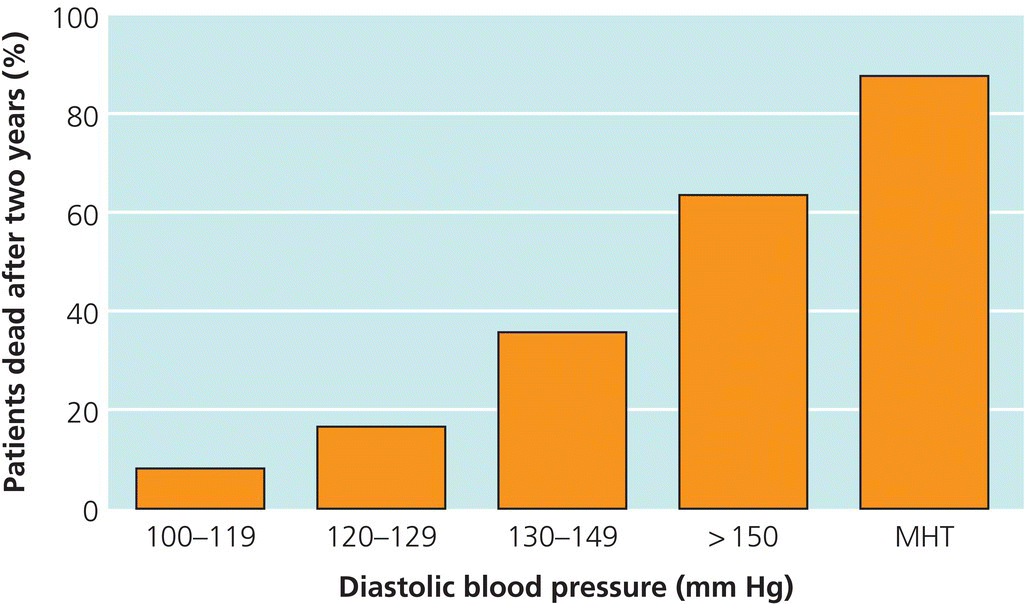
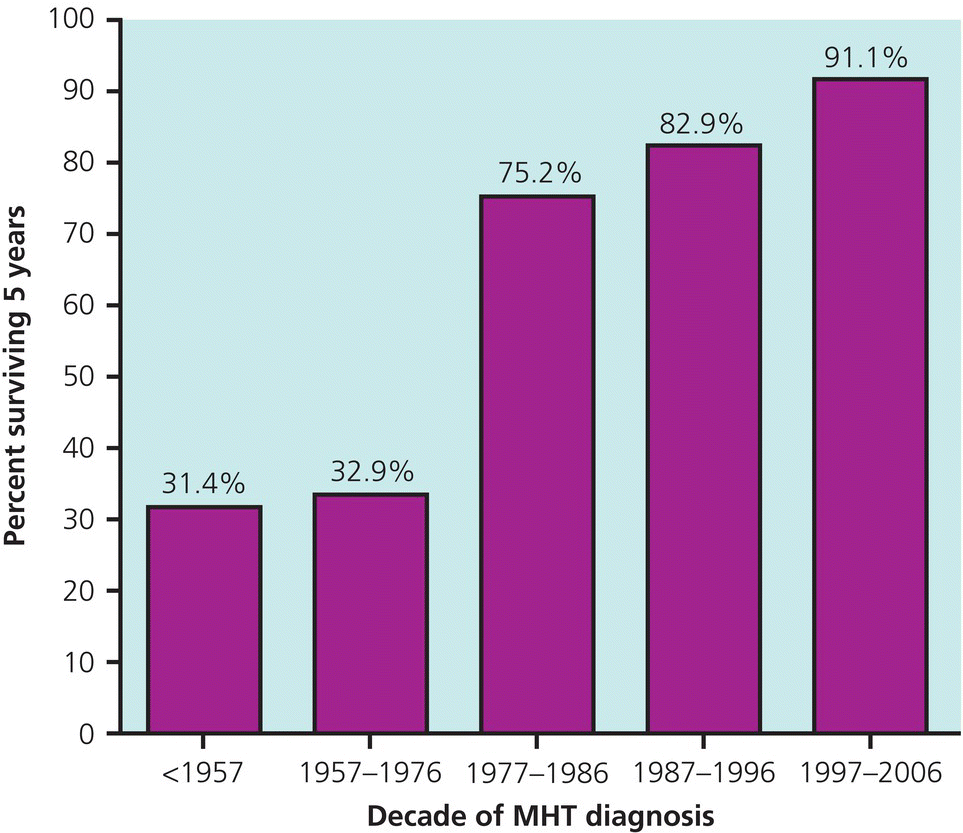
Malignant hypertension
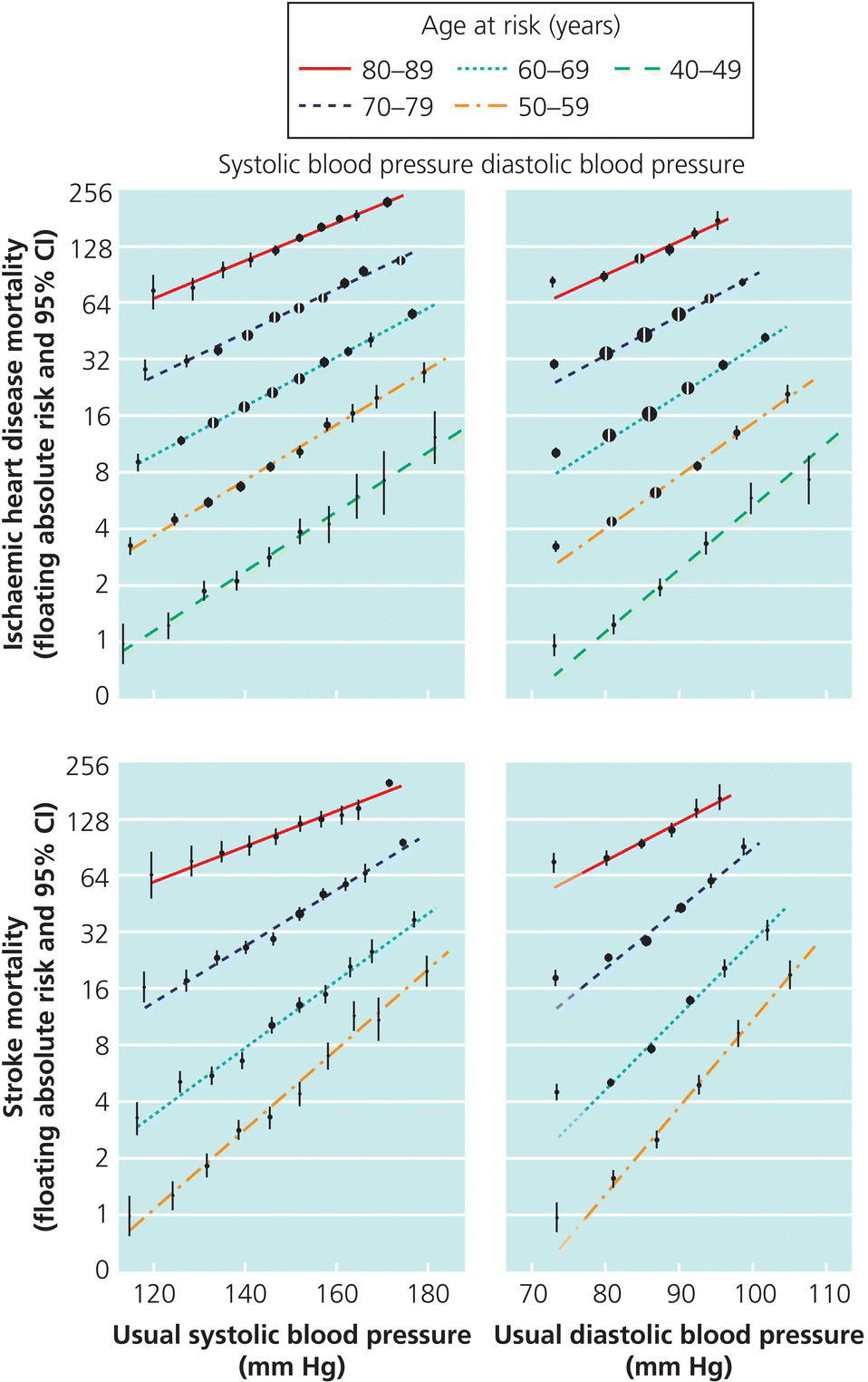
Systolic and diastolic blood pressures
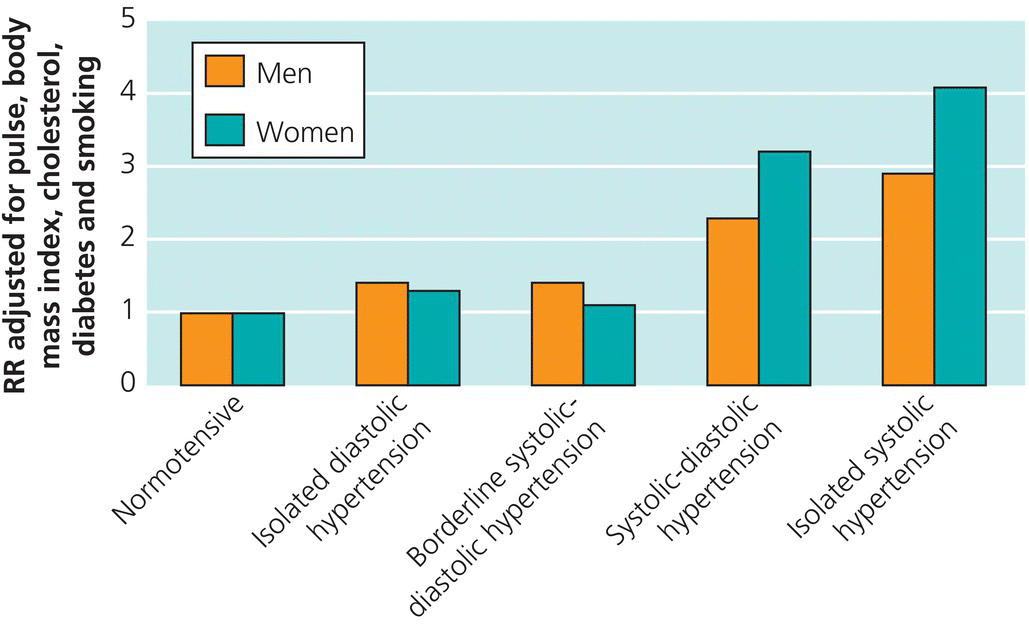
White coat hypertension
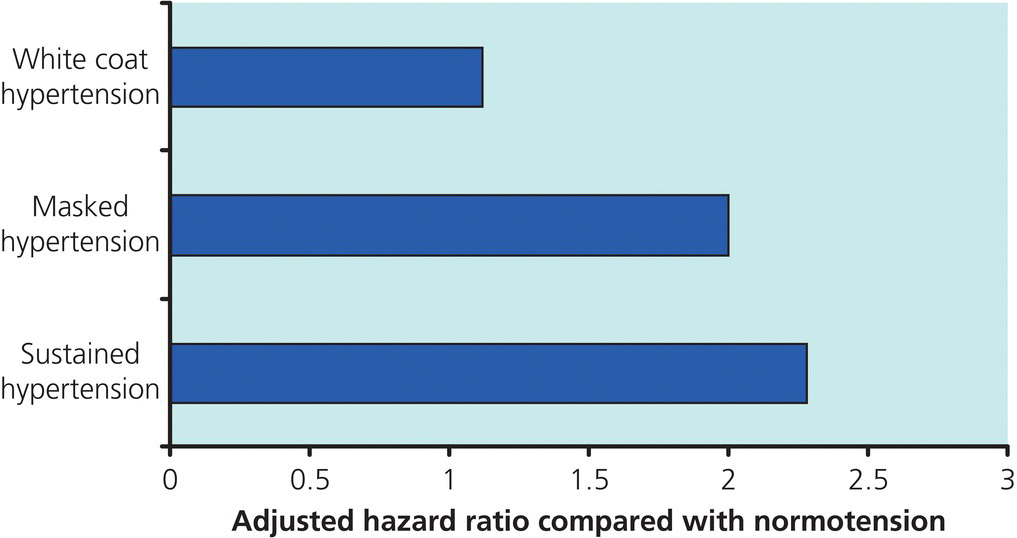
ABPM versus CBPM (nine studies):
HBPM versus ABPM versus CBPM (two studies):
Cardiovascular diseases and blood pressure
Stroke
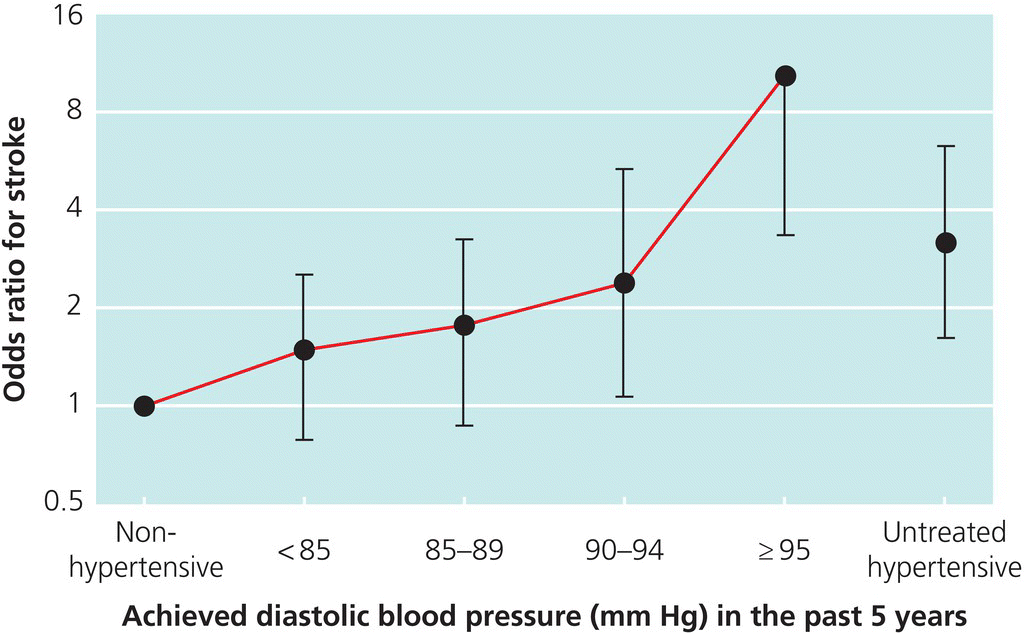
Atrial fibrillation
Score
C
Congestive cardiac failure or left ventricular dysfunction
1
H
Hypertension of BP ≥140/90 mm Hg
1
A
Age ≥ 75 years
2
D
Diabetes mellitus
1
S
Stroke or systemic thromboembolismansient or transient ischaemic attack
2
V
Vascular disease (previous myocardial infarction, PVD, or aortic plaque
1
A
Age 65–74 years
1
S
Sex female
1
Maximum possible score
9
Dementia
Coronary heart disease
Left ventricular hypertrophy
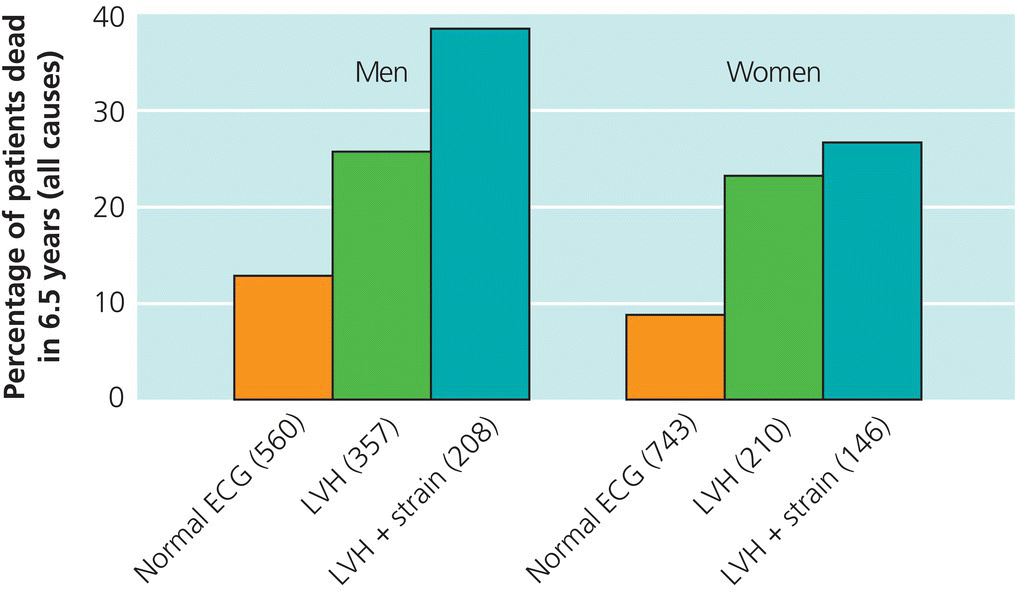
Hypertension and vascular risk
Only gold members can continue reading. Log In or Register to continue

Full access? Get Clinical Tree


